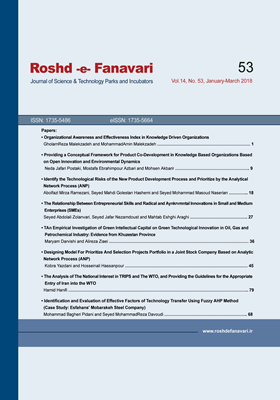-
-
List of Articles
-
Open Access Article
1 - Designing Model For Prioritize And Selection Projects Portfolio in a Joint Stock Company Based on Analytic Network Process (ANP)
کبری يزدانی Hossein Ali Hassan pour -
Open Access Article
2 - Effective Factors for Iran's Proper Entry into the World Trade Organization
Hamid Hanifi -
Open Access Article
3 - The Relationship Between Entrepreneurial Skills and Radical and Aynkrvmntal Innovations in Small and Medium Enterprises (SMEs)
Abdolali Zolanvari jafar nezamdost mahtab eshghiaraghi -
Open Access Article
4 - Organizational Awareness and Effectiveness Index in Knowledge Driven Organizations
Gholamreza Malekzadeh Mohhamad Amin Malekzadeh -
Open Access Article
5 - An Empirical Investigation of Green Intellectual Capital on Green Technological Innovation in Oil, Gas and Petrochemical Industry: Evidence from Khuzestan Province
maryam darvishi alireza ziaei -
Open Access Article
6 - Identify the Technological Risks of the New Product Development Process and Prioritize by the Analytical Network Process (ANP)
Abolfazl mirzaramazani Sayed Mahdi Golestan Hashemi Seyed Mohammad Massoud naserian -
Open Access Article
7 - Providing a Conceptual Framework for Product Co-Development in Knowledge Based Organizations Based on Open Innovation and Environmental Dynamics
Neda Jafari Pastaki Mostafa Ebrahim pour Azbary Mohsen Akbari -
Open Access Article
8 - Identification and Evaluation of Effective Factors of Technology Transfer Using Fuzzy AHP Method (case study: Esfahan’s Mobarakeh Steel Company)
Mohammad bagheri pebdeni sayyed mohammad reza davoodi
-
The rights to this website are owned by the Raimag Press Management System.
Copyright © 2017-2025







